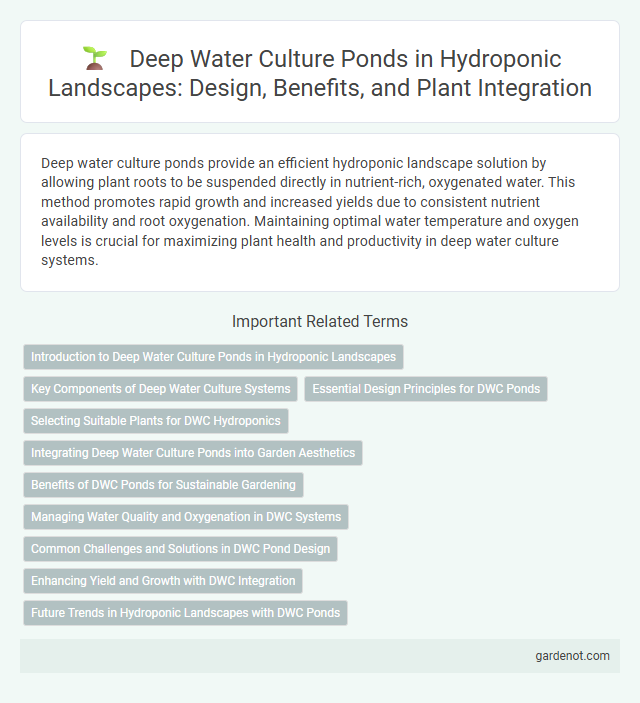Deep water culture ponds provide an efficient hydroponic landscape solution by allowing plant roots to be suspended directly in nutrient-rich, oxygenated water. This method promotes rapid growth and increased yields due to consistent nutrient availability and root oxygenation. Maintaining optimal water temperature and oxygen levels is crucial for maximizing plant health and productivity in deep water culture systems.
Introduction to Deep Water Culture Ponds in Hydroponic Landscapes
Deep Water Culture (DWC) ponds in hydroponic landscapes provide a nutrient-rich, oxygenated water environment where plant roots are suspended directly in the solution, promoting rapid growth and high yields. These systems rely on efficient aeration to maintain dissolved oxygen levels critical for root health, often using air stones or diffusers within the pond. DWC ponds optimize space and resource use, making them ideal for commercial hydroponic farming of leafy greens, herbs, and other high-value crops.
Key Components of Deep Water Culture Systems
Deep Water Culture (DWC) systems rely on essential components such as nutrient-rich oxygenated water reservoirs, buoyant net pots supporting the plant roots, and an air pump with air stones to supply continuous oxygenation. These key elements maintain root health and optimize nutrient uptake by suspending roots directly in the oxygenated solution. The integration of water pumps and filtration units enhances water circulation and prevents stagnation, ensuring consistent growth conditions in hydroponic landscapes.
Essential Design Principles for DWC Ponds
Essential design principles for Deep Water Culture (DWC) ponds include maintaining optimal water depth between 20-30 centimeters to ensure adequate root suspension and oxygenation. A robust aeration system, typically involving air stones connected to an air pump, is crucial for delivering dissolved oxygen directly to plant roots, preventing root rot and promoting healthy growth. The pond's materials must ensure chemical inertness and durability, while water circulation should be optimized to prevent stagnation and evenly distribute nutrients throughout the pond.
Selecting Suitable Plants for DWC Hydroponics
Selecting suitable plants for Deep Water Culture (DWC) hydroponics involves choosing varieties with strong root systems adapted to constant water submersion, such as lettuce, basil, and spinach. Crops that thrive in nutrient-rich, oxygenated water and exhibit rapid growth cycles enhance yield efficiency in DWC ponds. Ensuring plant compatibility with hydroponic nutrient solutions and maintaining stable pH levels between 5.5 and 6.5 optimizes growth and prevents root diseases.
Integrating Deep Water Culture Ponds into Garden Aesthetics
Deep Water Culture ponds enhance garden aesthetics by seamlessly blending hydroponic systems with natural water features, creating a visually striking and functional landscape element. Incorporating floating rafts with thriving aquatic plants and colorful fish complements traditional garden designs while promoting sustainable growth using nutrient-rich water environments. Thoughtful placement of these ponds harmonizes aquatic biodiversity with decorative elements, elevating both the ecological value and beauty of hydroponic gardens.
Benefits of DWC Ponds for Sustainable Gardening
Deep water culture (DWC) ponds offer a significant advantage in sustainable gardening by providing an oxygen-rich environment that promotes rapid root growth and efficient nutrient uptake. These systems reduce water usage by recirculating nutrient solutions, minimizing waste compared to traditional soil gardening. The integration of DWC ponds supports eco-friendly cultivation with reduced dependency on pesticides and fertilizers, enhancing plant health and yield.
Managing Water Quality and Oxygenation in DWC Systems
Managing water quality and oxygenation in Deep Water Culture (DWC) systems is crucial for healthy plant growth and nutrient absorption. Maintaining dissolved oxygen levels above 6 mg/L prevents root suffocation and promotes beneficial microbial activity, while regular monitoring of pH (5.5-6.5) and Electrical Conductivity (EC) ensures optimal nutrient availability. Implementing aeration devices like air stones or diffusers enhances oxygen distribution, reducing root diseases and supporting vigorous hydroponic crop yields.
Common Challenges and Solutions in DWC Pond Design
Deep Water Culture (DWC) ponds face common challenges such as oxygen depletion, root rot, and nutrient imbalances, which can severely affect plant growth and yield. Solutions include installing efficient aeration systems like air stones or diffusers to maintain dissolved oxygen levels, implementing regular water quality monitoring to manage pH and nutrient concentrations, and using net pots or root barriers to prevent root entanglement and decay. Proper pond design incorporating these strategies enhances oxygen distribution, promotes healthy root development, and ensures optimal nutrient availability for robust hydroponic plant growth.
Enhancing Yield and Growth with DWC Integration
Deep water culture (DWC) ponds optimize root oxygenation by suspending plant roots in nutrient-rich, aerated water, significantly enhancing plant growth rates and crop yields. Integrating DWC within hydroponic landscapes enables efficient nutrient uptake and consistent environmental control, promoting robust plant development. This method reduces water usage and space requirements while maximizing biomass production in various crop types.
Future Trends in Hydroponic Landscapes with DWC Ponds
Deep water culture (DWC) ponds are revolutionizing hydroponic landscapes by enabling scalable, efficient nutrient delivery systems that support diverse plant growth. Future trends emphasize integrating smart sensors and automated controls to optimize oxygenation and nutrient levels, boosting yield and reducing resource waste. The adoption of sustainable materials and renewable energy sources in DWC pond construction further aligns this technology with eco-friendly agricultural practices.
Deep water culture pond Infographic

 gardenot.com
gardenot.com